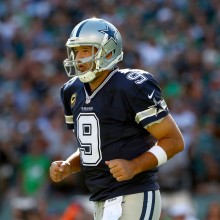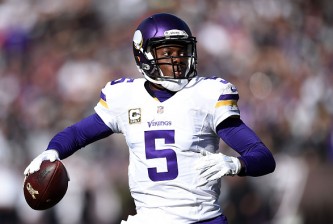
The best of the NFL‘s best gathered together for one, last, final last game. The ultimate contest of the season, where fans say goodbye to the best and brightest, envy the gorgeous, exotic scenery and big fat coaches wear loud ugly shirts.
The NFL Pro Bowl.
Since 1950, the NFL’s best have capped the season with this star-studded exhibition game. For decades, the lure of a fat bonus (and, since 1979, a Hawaiian vacation) drew all the NFL’s best to play with each other, have some fun and send off the fans with a fantasy-football style mashup of all their favorite players.
Why does the NFL want to kill it?
Just to make sure I have this straight — the Pro Bowl is the National Football League’s All-Star Game. Arguably the most powerful sports league in the world, it puts on a showcase of its top talent.
The Pro Bowl Is “D.O.A”
According to ESPN’s Chris Mortensen, the NFL is likely to shelve the Pro Bowl. Every year, fewer and fewer of the league’s marquee players choose to hike out to Hawaii. Every year, the multi-million dollar contracts make those bonuses less and less attractive. Every year, the prospect of injury ruining teams’ investments loomed larger.
The tide started to turn against the Pro Bowl when the New England Patriots star rookie tailback, Robert Edwards, destroyed his knee in a pre-Pro Bowl beach football game. Ever since, players and teams alike began turning the intensity way, way down.
This caused its own set of problems. Some players kept going all-out, while others were playing patty cake. The late Redskins safety Sean Taylor dramatically illustrated this during the 2006 Pro Bowl. Bills punter Brian Moorman tried to convert a fake punt, and Taylor realized he could light Moorman up.
That he did.
http://youtube.com/watch?v=pNtmxsGY0pA?wmode=Opaque
Moorman, to his credit, took the punishment, bounced right up and congratulated Taylor on his bone-crushing play. But the danger was obvious: When some guys are playing around while others are playing, the potential for injury is much greater.
So, players stopped playing.
The Pro Bowl Isn’t Football Anymore
The last few Pro Bowls have felt like Kabuki theatre: a brightly-colored, elaborate presentation of something that looks like football but is obviously not.
Oh, and here’s the rules that have made the Pro Bowl “safer” for years: No motion or shifting by the offense. The offense must have a tight end in all formations. The offense can’t have three receivers on a side. Intentional grounding is legal. The defense must run a 4-3 at all times. No press coverage is allowed except inside the 5-yard line. No blitzing. Players aren’t allowed to rush a punt, PAT or field-goal attempt and no calls can be challenged.
Extreme walking is more dangerous.
With TV ratings declining, the NFL tried scheduling the Pro Bowl before the Super Bowl instead of after; this ruined the game’s “curtain call” feel and prevented the Super Bowl-bound players from playing.
For the 2009 season’s Pro Bowl, the NFL tried moving it to Miami. This was another mistake: The multimillionaire players still considered a Hawaiian vacation exotic; going to Miami was routine.
“I just think you take away from everything the Pro Bowl means,” Baltimore Ravens linebacker Ray Lewis told the Associated Press. “I don’t understand it all.”
Lewis, who played college football at the University of Miami, decried the loss of the game’s specialness.
“That’s no vacation,” Lewis said. “That’s what we regularly do. You don’t want to go to the Pro Bowl and do what you regularly do. You want to come over and do something different. You want to tour the islands and bring the kids over here to see something different.”
Every other major American sport has an All-Star game. While they’re all facing similar problems, each of them maintain a strong following and are innovating in successful ways (like the NHL’s schoolyard-style draft). The Pro Bowl used to be great, and the NFL is too good to give up on it.
Move It to the Middle of the Season
Every other All-Star game is played in the middle of the season. There are a few reasons for that.
First, the makeup of the team. Though the Pro Bowl takes place at the end of the postseason, voting occurs from the middle of the season and closes before Christmas. With voting over with weeks left to go in the regular season and playoffs, players with great second-half and postseason performances are often snubbed; players with hot starts or name recognition get undeserving berths.
It’s shockingly obvious: If you’re going to decide the team in the middle of the season, have the game in the middle of the season.
With the NFL keen to expand to an 18-game regular season, a midseason “All-Star break” could assuage many of the concerns about players tiring out. Instead of staggered, rotating bye weeks (which have never made any sense), the entire NFL should take two weeks off in the middle of the season and play the Pro Bowl during the layover stretch.
Have a Pro Bowl Combine
Many have suggested a Pro Bowl skills competition, like New York Times blogger Toni Monkovic. The league has made halfhearted attempts at this before, but didn’t make it a prime-time extravaganza, as the NHL and NBA do.
Again, the answer is obvious. The NFL needs to borrow from an offseason event the public can’t get enough of: Have a Pro Bowl Combine, 40-yard dash, bench press, receiver drills, the whole works. The comparison of professional NFL players to green college hopefuls might open some eyes, too.
Oh, and bring back the awesome NFL Quarterback Challenge that’s languished unaired for years.
The players would get into it for the competition, and the fans would get into it for the same reason. Who wants to settle some bets? Put this on at 8 ET on a Wednesday night, mic everyone up and wait for the ratings to roll in.
Up the Stakes
The traditional Pro Bowl bonus is $50,000 for the winning side, and half that for the defeated. Most of the financial incentive to play in the Pro Bowl comes from contract bonuses; the NFLPA is not thrilled with the idea of eliminating those incentives.
First, multiply those bonuses by at least five times, maybe 10. For some of the Pro Bowl players, winning $500,000 would nearly double their annual salary.
But what about the teams? What incentive do they have to let their stars play a full-speed game midseason?
Make it worth their while, too.
Eliminate the seventh round of the draft, and award compensatory fourth-round picks to the teams of the winning conference, and compensatory sixth-round picks to the teams represented in the losing conference. Teams not represented in the Pro Bowl at all would receive compensatory fifth-round picks, preventing the the rich from getting too much richer.
Play a Real Game
The greatest attraction of the Pro Bowl is to see the NFL’s biggest stars—trapped on different teams—play with each other. Great quarterbacks and receivers, great defenders and linemen, all getting a taste of playing with and against each other in a new environment.
The key is that fantasy football feel: Brett Favre throwing to Terrell Owens, Barry Sanders running behind the Cowboys offensive line and Wilber Marshall lining up next to Lawrence Taylor. If the players are all in, their teams are all in and there’s a football-starved audience of millions, the fixed NFL Pro Bowl will be far too compelling to throw away.






















